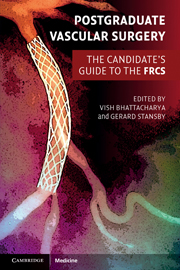Book contents
- Frontmatter
- Contents
- List of contributors
- Preface
- Section 1 Final FRCS vascular clinicals
- Section 2 Final FRCS vascular topics
- 1 Vascular risk factors and their management
- 2 Management of acute limb ischaemia
- 3 Chronic lower limb ischaemia, critical ischaemia and the diabetic foot
- 4 Endovascular and surgical options for peripheral revascularisation
- 5 Abdominal aortic aneurysms
- 6 Thoracic, thoracoabdominal and suprarenal aortic aneurysms
- 7 Aortic dissection
- 8 Popliteal artery aneurysms
- 9 Femoral artery aneurysms
- 10 Carotid, subclavian and vertebral disease
- 11 Diagnosis and management of thoracic outlet syndrome
- 12 Diagnosis and management of hyperhidrosis
- 13 Chronic mesenteric ischaemia
- 14 Acute ischaemic colitis
- 15 Vascular trauma
- 16 Indications and management of lower limb amputation
- 17 Leg swelling and lymphoedema
- 18 Varicose veins and chronic venous insufficiency
- 19 Management of deep vein thrombosis
- 20 Infection in vascular surgery
- 21 Vascular malformations
- 22 Vasospastic disorders and vasculitis
- 23 Critical care considerations and preoperative assessment for general and vascular surgery
- 24 Access surgery
- 25 Basic outline of solid organ transplantation
- Index
- References
19 - Management of deep vein thrombosis
- Frontmatter
- Contents
- List of contributors
- Preface
- Section 1 Final FRCS vascular clinicals
- Section 2 Final FRCS vascular topics
- 1 Vascular risk factors and their management
- 2 Management of acute limb ischaemia
- 3 Chronic lower limb ischaemia, critical ischaemia and the diabetic foot
- 4 Endovascular and surgical options for peripheral revascularisation
- 5 Abdominal aortic aneurysms
- 6 Thoracic, thoracoabdominal and suprarenal aortic aneurysms
- 7 Aortic dissection
- 8 Popliteal artery aneurysms
- 9 Femoral artery aneurysms
- 10 Carotid, subclavian and vertebral disease
- 11 Diagnosis and management of thoracic outlet syndrome
- 12 Diagnosis and management of hyperhidrosis
- 13 Chronic mesenteric ischaemia
- 14 Acute ischaemic colitis
- 15 Vascular trauma
- 16 Indications and management of lower limb amputation
- 17 Leg swelling and lymphoedema
- 18 Varicose veins and chronic venous insufficiency
- 19 Management of deep vein thrombosis
- 20 Infection in vascular surgery
- 21 Vascular malformations
- 22 Vasospastic disorders and vasculitis
- 23 Critical care considerations and preoperative assessment for general and vascular surgery
- 24 Access surgery
- 25 Basic outline of solid organ transplantation
- Index
- References
Summary
Key points
Deep vein thrombosis (DVT) and pulmonary embolism (PE) are the leading causes of preventable in-patient mortality following surgery
Virchow's triad (stasis, hypercoagulable state, vessel wall injury) forms the basis for DVT formation
Many DVTs are asymptomatic
Heparin prevents propagation by its action on antithrombin III
D-dimer level measurements are useful screening tests
Heparin must be overlapped with warfarin because of the transient hypercoagulable state induced by warfarin
Outpatient treatment is carried out with low molecular weight heparin (LMWH) and warfarin
Newer anticoagulants such as rivoraxaban and dabigatran are now being used for prophylaxis
Inferior vena cava filters can be used when anticoagulation is contraindicated
Background
DVT and its sequela, PE, are the leading causes of preventable in-hospital mortality. In 1846, Virchow recognized the association between venous thrombosis in the legs and PE. Heparin was only introduced to clinical practice in 1937. Over the last 25 years, considerable progress has been made in understanding the pathophysiology, diagnosis, treatment and prevention of venous thromboembolism (VTE). Many DVTs are asymptomatic and almost half of all fatal cases of PE are associated with asymptomatic DVTs.
Pathophysiology
DVT is multifactorial with interaction between hereditary and acquired risk factors. The Virchow triad (i.e. venous stasis, hypercoagulable state, vessel wall injury), continues to serve as the unifying concept in the pathogenesis of DVT. However the significance of interplay between the elements of Virchow's triad and environmental or acquired risk factors is also important.
- Type
- Chapter
- Information
- Postgraduate Vascular SurgeryThe Candidate's Guide to the FRCS, pp. 220 - 228Publisher: Cambridge University PressPrint publication year: 2011

